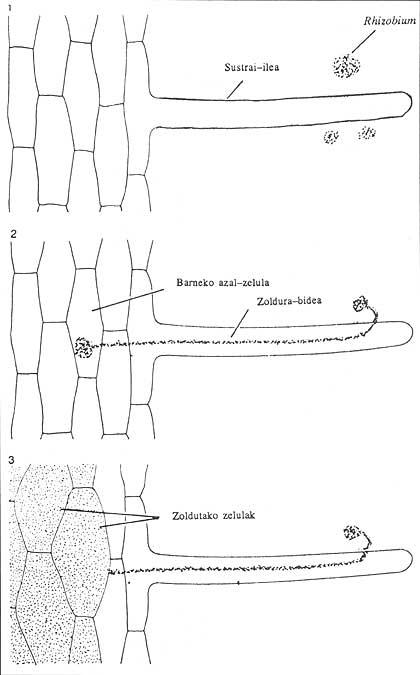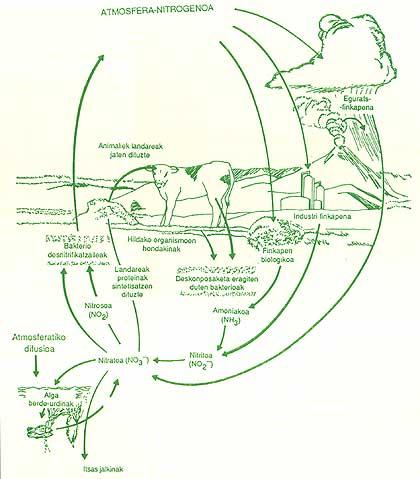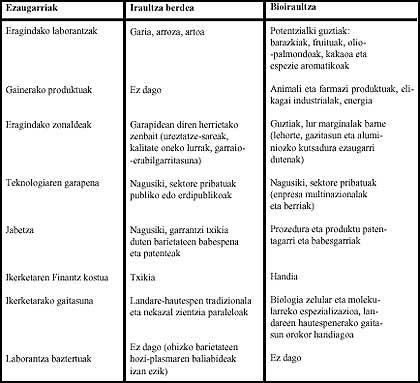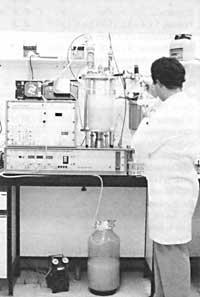Agricultural microbiology
1988/08/01 Gonzalez, Edorta Iturria: Elhuyar aldizkaria

Today, after the Green Revolution, so important in the Third World, the Biotechnology Revolution has brought us closer. This relates the biochemical and genetic capacities of living organisms to practical objectives of interest to humans. Biotechnology techniques in the agricultural field can be classified into two categories: primary production (on the one hand, in terms of plant improvement and nitrogen fixation) and waste biotransformation (in terms of energy and food production).
These new techniques have brought enough crops. For example, in the last thirty years maize yield has multiplied by five and in the case of rice 60,000 varieties have been obtained. These procedures are of three levels: phytological, genetic and microbiological. Many times these areas are closely related. However, for our part, we will only publish agricultural microbiology.
Scientists, after conducting their experiments, often observe that bacteria that respond biologically in the laboratory do not act in the same way in the fields of cultivation, since the production of plants associated with these microorganisms is very low. Agriculture, therefore, offers numerous examples of differences between what happens in fermentation tanks and crop fields. Biologists must bear in mind that the fermentation tank is a very concrete medium. All physical, chemical and biological variables are controlled. In addition, there is only one kind of microorganism. If we want to apply it to agriculture, we must analyze both the interaction between microorganisms and the relationships with the biosphere.
Nitrogen fixation
Let's see the contracted applications. For example, agricultural microbiology could solve an interesting problem: nitrogen fixation. In many villages, extensive studies have been initiated to ensure that plants properly settle atmospheric nitrogen. We know that the baserritarras must throw nitrogen fertilizers so that the plants take nitrogen, with the economic costs and the ecological consequences that this entails. The best solution, as mentioned above, would be to fix nitrogen from the air, that is, take this element biologically useful. To understand the process, let's first look at the nitrogen cycle:
The nitrogen cycle maintains the balance between the two great sources of nitrogen compounds, the Atmosphere and the Earth's Crust. Green plants can only use nitrogen when this element is within chemical compounds such as ammonia (NH 3). That is why they cannot take nitrogen directly from the atmosphere. In fact, the atmosphere is in the form of a diatomic molecule (N 2). All of this causes nitrogen to be industrially fixed through bacteriological or natural processes (e.g., lightning storms). Plants need little nitrogen, but continuously, as the soil loses nitrogen through drainage and harvest. In addition, we must not forget another nitrogen loss, caused by denitrifying bacteria.
The bacteria of the genus Rhizobium infect the roots of certain leguminous plants, but this is not at all a pathogenic process. The plant, for its part, maintains a symbiotic relationship with the microorganism: the plant provides nutrients to the bacteria and the latter nitrogen (in the form of NH 3) to the plant. After entering the roots of the legume Rhizobium, it generates spectacular lumps, called nodules.
Let's look at a root infection:
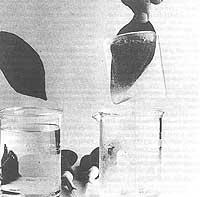
In the infection bacteria stick to the root hair. Plants and microorganisms are known by specific proteins. Soon after they get into the brush and head towards a root cell. The infection causes inflammation and cell separation. The consequence is the formation of the nodule. It contains a dense group of cells infected by symbiotic bacteria.
Rhizobium was isolated in 1888 and fifteen years later it was inoculated in the fields, considerably increasing agricultural production. At present, the different returns of this species are packed together with the crushed peat for dispersion through the grounds. Nitrogen is essential in plant metabolism. As we know, it participates in numerous biological compounds. For example, protein units, amino acids, need nitrogen to build peptide bonds between them. When the plant dies, the amino acids degrade and appear in the form of ammonia or nitrate ion (NO 3 –). Subsequently, nitrifying bacteria transform nitrates into molecular nitrogen (N 2), which is returned to the atmosphere. This closes the nitrogen cycle.
Harvesting, denitrifying bacteria and soil cleaning by rain lead to fixed nitrogen loss. This nitrogen lost or, rather, returned to the ground if the plants of the next crop are desired to synthesize the proteins necessary for its development.
Nitrogen fixation is not exclusive to the genus Rhizobium. We have other examples: The actinomicete Frankia alni, a fungus, does the same with the alder in its relations of symbiosis. Thus, in the woods you can alternate worship with the spruce and the Douglas poplar. On the other hand, some bacteria only fix nitrogen, that is, without being in symbiosis with plants.
Research is being conducted with the aim of fine-tuning Azotobacter vinelandii in the roots of corn. In addition, using genetic engineering passed genes from Rhizobium to A. vinelandiite. In this way the last microorganism adheres to the roots of clover. The same genetic technique is intended to refine the roots of A. vinelandii maize, but this union with maize growing in the United States is, for the moment, impossible. The aim of advanced studies would be to introduce nitrogen fixing genes into crops. However, this is considered very complicated.
Biologists at the University of California, Berkeley, discover that the addition of Pseudomonas putida bacteria to sugar beet or potatoes increases the performance of these plants. It seems that the microorganism secretes several chemical compounds and these substances are combined with terrestrial iron. Pathogenic fungi and bacteria cannot assimilate this new form of iron. Therefore, pathogenic microorganisms cannot attack the plant.
Agricultural microbial genetics
At the heart of this problem is deoxyribonucleic acid (DNA). That is, it carries coded genetic orders that will guide the behavior of cells and, consequently, the behavior of plants, animals or microbes. This unfinished DNA molecule can be divided into parts—in genes—on which specific characteristics depend. The product resulting from the artificial combination of DNA fragments from different organisms is called recombinant DNA.
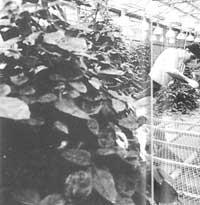
Genetic manipulations are the breakthrough of biotechnology in the last ten years: the use of microbes and other unicellular organisms. From them a series of useful drugs and substances have been obtained and an impulse has been given to industrial processes.
Another genetic strategy is often used in agricultural microbiology: introducing a plant gene into the bacteria. To do this, we cut the gene that interests us with different enzymes (restriction endonucleases) and then introduced it into the bacteria through a plasma – part of the DNA that is outside the bacterial chromosome – or a virus. Thus, in many laboratories plant genes have entered Escherichia coli. This does not mean that the bacteria produce the proteins corresponding to that gene. These genetic mechanisms are not entirely clear. If this were ever achieved, plant proteins would be obtained by growing bacteria in fermentation tanks.
Transferring genes from a microorganism to a plant is one of the finest methods that microbiology uses to help agriculture. Using recombinant DNA, the field of plant genes is certainly much more delayed than that of animal genes. However, the introduction of foreign genes has the same bases, even if the original cell is animal, vegetable or bacterial. Several studies have been conducted in the area of gene introduction in plant cells.
For example, Agrobacterium tumefaciens infects most dicotyledonous plants. This microbe carries a plasmid. This causes tumors in these plants. This agitation mechanism is called genetic colonization. In this process a piece of plasma DNA (DNA T) binds to the DNA of the plant cell. Therefore, the plasmid could be used as a vector (carrier) of introduction of foreign DNA into plant cells, as can be seen in Figure 4.
Cut the plasmid into a spot inside the DNA leaving a gap. That will fill the strange gene. Then DNA is repeated at the time of the division of tumor cells and the tumor cells we have in a tissue culture will carry DNA T. In some cases the entire plant will be regenerated from cultured tumor cells. As a result of this process it remains on plant chromosomes regenerated by DNA. What's more, the new gene inside the T-DNA will pass to the next plant balaunade with a dominant gene.

The most remarkable conclusion would be: Foreign genes generated inside the DNA would pass to offspring to obtain new plant varieties. Some scientists working at the Max Planck Plant Improvement Institute in Cologne have checked all of the above for the gene encoding the tobacco plant and the enzyme opina synthetase.
A group of researchers from Sussex University has also achieved a new genetic transfer. On this occasion, the genes responsible for nitrogen fixation in the bacterium Klebsiella neumoniae have been introduced into an E. coli plasma and subsequently introduced into a yeast. This is a great scientific breakthrough. In fact, yeasts are eukaryotes, so they are closer phylogenetically (in degree of kinship) to plants.
Another third type of research is the finding by researchers at the University of California, Berkeley, that if ice affects both strawberry plants, it is because bacteria that attract and fix ice crystals live on the leaves. This phenomenon is due to a protein of these microbes, and Californian biologists have been able to remove the gene that produces it, and thanks to this hope that strawberry plants, treated with this antiice bacterium, and in the hope that it reproduces naturally, the large damages of the ice, end in a term.
Another thing is that genetic engineers hope to improve biological insecticides that could be used instead of chemical insecticides that usually pollute the environment, which could kill parasites without contaminating the environment. For example, recombinant DNA techniques are improving the results of the bacillus thuringiensis bacillus, used for years to eliminate harmful species. It highlights the case of the worm that touches the pines of northern England. In other regions the parasitic vulture is controlled by a vacuolar virus that infects worms.
Now this virus is cultivated to spread it in pine forests and enhance its destructive effect. At the moment, the experiments are carried out with an unaltered virus, but that in part of the DNA without gene code carries a mark to be able to analyze in situ its propagation or resistance. If everything goes well, the virus will be injected with a gene capable of synthesizing an insecticide toxin. It should not be said that these techniques violate broad occlusion pathways against harmful insects in other countries.
Advances in biotechnology
To know the advance of biotechnology in agrarian matters with respect to the Green Revolution, the following table shows the differences between the two:
Research bodies in agricultural microbiology
The saying that most scientists speak is that research aids are also very scarce. We know whether these complaints are reasonable or not.
As for the case of the United States, in 1982 the Reagan administration gave the Department of Agriculture $691 million for the investigation. This year was 5.3% of the budget for basic and applied research. However, only a small part of this amount reached the area of agricultural microbiology. As an example, in the basic study of nitrogen fixation, plant improvement genetic mechanisms, environmental pressure situations, basic research into plant growth and human food needs was spent only $26 million.
The microbiology area received 4.6 million. These figures are, of course, very small and occur in the most advanced country. Therefore, in the Third World one can easily sense that the situation is much more worrying and we cannot forget that in these poor countries the needs in agricultural matters are enormous, since the ghost of hunger is constantly advancing.
In the following table you can compare the number of biotechnologists:

As is evident, developing countries have a huge lack of experts and biotechnologists. It is undoubtedly one of the best ways of territorial and international cooperation in this area to move to poor countries and fulfill their promises. Also to solve the problems posed by this problem. This collaboration is channeled through bilateral agreements between companies and private sector entities. Within UNESCO, for example, the institutions and meetings dealing with these issues are:
UNESCO
ENTITY
1.- MIRCEN: Microbiological Resources Centers. It is a worldwide network.
Objective: collection, care and use of microbial slags for national development and international cooperation.
VIAS
2.- IGAM: Scientific meetings on the effects of applied microbiology worldwide.
Objective: Foster cooperation between industrial and developing countries, promote local research and training.
3.- United Nations non-governmental organizations and organizations
- COLLABORATION: Among the following organizations:
- FAO: Organization for Food Agriculture.
- UNDP: United Nations Development Programme.
- UNEP: United Nations Environment Programme.
- UNIDO: United Nations Industrial Development Organization.
- ICRO: International Institute of Cell Research. This is the Working Group on Microbiology and Biotechnology.
- IFS: International Scientific Foundation.
- OMIC: International Organization for Biotechnology and Bioengineering.
- IUMS: Union of International Microbiology Organizations.
- WFCC: World Federation for Crop Collections.
4.- Collaboration with regional entities:
- ALAR: Latin American Rizobiology Association
- NFPA: African Association for Biological Nitrogen Fixation
- ABEGS: Arab State Education Office
- CEC: Commission of European Associations
- SANEM: Asia-Southeast Microbiological Network.


Gai honi buruzko eduki gehiago
Elhuyarrek garatutako teknologia




